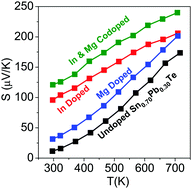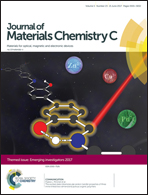An enhanced Seebeck coefficient and high thermoelectric performance in p-type In and Mg co-doped Sn1−xPbxTe via the co-adjuvant effect of the resonance level and heavy hole valence band†
Abstract
Recently, tin telluride (SnTe) has drawn much attention as a potential candidate for thermoelectric power generation. Herein, we report the high thermoelectric performance in SnTe achieved through a two-step design (a) reduction in lattice thermal conductivity via solid solution alloying and (b) enhancement of the Seebeck coefficient (S) via the modification of the electronic structure through co-doping. First, we demonstrate that the introduction of Pb into the position of Sn in SnTe decreases the excess of p-type carrier concentration in SnTe. Notably, the Sn0.70Pb0.30Te sample exhibits a κlatt value of ∼0.67 W m−1 K−1 at 300 K, which is close to the theoretical minimum limit of the κlatt in SnTe, which results mainly from scattering of heat carrying phonons by solid solution point defects. Secondly, we achieve an S value of 121 μV K−1 at 300 K, which increases to ∼241 μV K−1 at 710 K for In and Mg co-doped Sn0.70Pb0.30Te, which is the highest Seebeck coefficient among all the state-of-the-art SnTe based materials known so far. Indium acts as a resonant dopant, leading to a remarkable enhancement in the Seebeck coefficient mainly near room temperature, whereas Mg doping enables the valence band convergence in Sn0.70Pb0.30Te, which is confirmed by density functional theory (DFT) calculations of its electronic structure. As a result of co-doping, a remarkable enhancement in the Seebeck coefficient over a wide range of temperatures is achieved due to the synergistic effect of resonance level formation and valence band convergence. Hence, we have achieved a maximum zT of 1 at 710 K for In and Mg co-doped Sn0.70Pb0.30Te. Notably, an average zT (zTavg) of ∼0.6 is achieved in the temperature range of 300–710 K for the Sn0.655Mg0.04In0.005Pb0.30Te sample.

- This article is part of the themed collection: Journal of Materials Chemistry C Emerging Investigators


 Please wait while we load your content...
Please wait while we load your content...